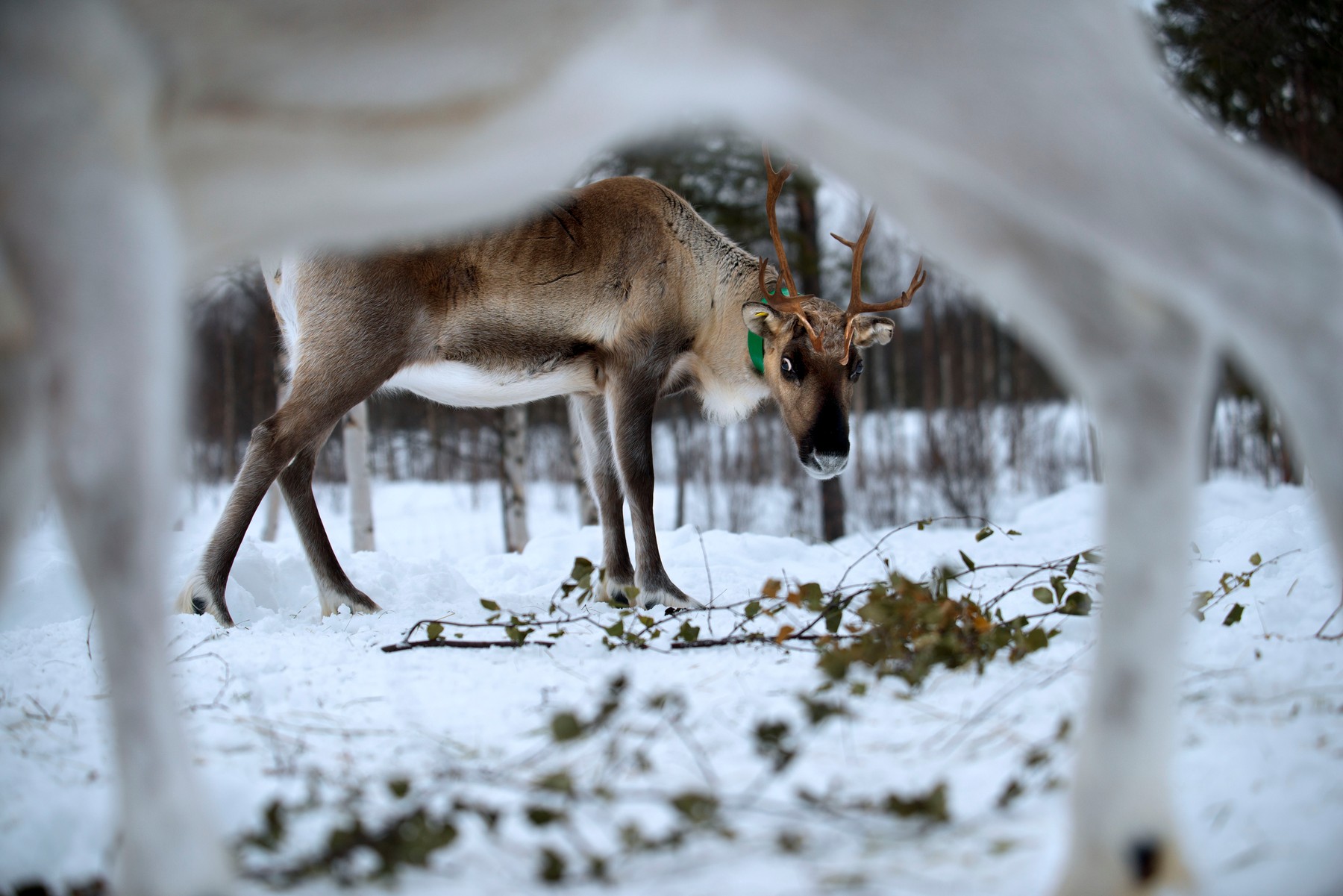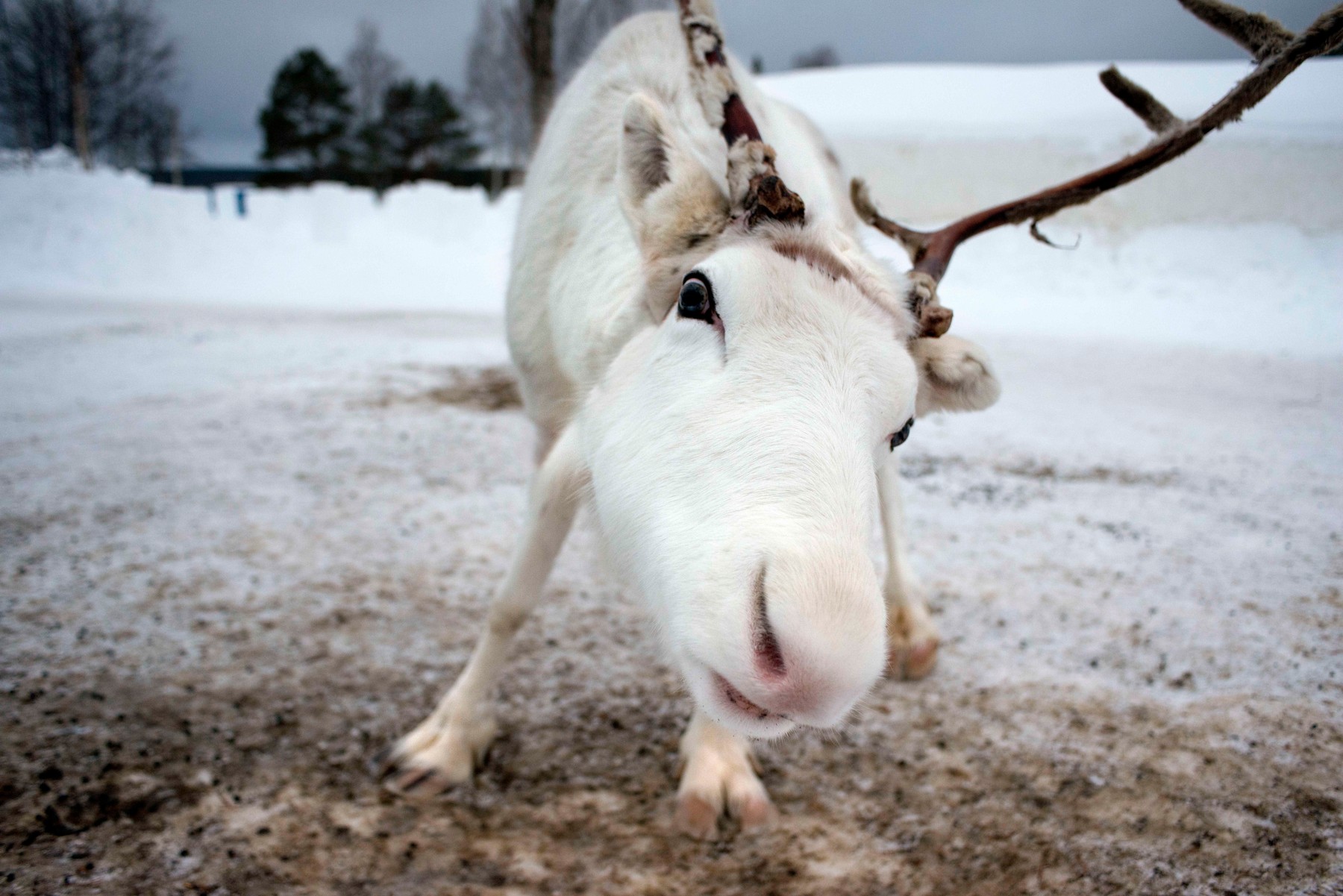
Reindeer are loved around the world for their distinctive black eyes, majestic antlers and magical association with Santa Claus. But reindeer are even more special, writes The Conversation.
The arctic reindeer, like its main predator, the wolf, is incredibly well adapted to its snowy home, where the temperature can drop to -50°C in winter and the light level decreases.
Reindeer have a second coat of fur, wide, crescent-shaped hooves that allow them to stand on their feet and dig through snow, and, according to new research published this summer in the Proceedings of the Royal Society, eyes that undergo a physical transformation during transition between seasons, which allows them to see clearly in the long winter twilight.
In the middle of winter in the Arctic, it is either dark or twilight – when the sun is behind the horizon all day.
Reindeer have to find and extract their winter food – lichens – from under the snow, digging into the slush with their hooves, horns and snouts.
Lichens in the arctic are more than enough, being an ideal food source for reindeer wherever they are, they feed at dusk, so wolves also hunt then.

PHOTO: Krissikunterbunt / Alamy / Profimedia Images
Dusk, deer and light
Twilight has a unique quality that sets it apart from day or night: it is extremely blue, containing very little green, yellow, or orange light.
This is because when the sun is below the horizon, the Earth’s ozone layer acts as a giant filter that absorbs almost all light except blue.
Sunlight travels a greater distance through the atmosphere, passing horizontally through the ozone layer. And this ozone-filtered blue color is different from the color of the sky on a cloudless day, caused by the scattering of sunlight by air molecules.
Although artists call this period after sunset the “blue hour,” we tend to overlook it as our eyes gradually become accustomed to the color change.
As darkness approaches, our vision shifts from using cone receptors, which allow us to see color, to using rod cells, which are great for detecting dim light at night, but less so for detecting colors.
And in the polar regions, twilight can last more than a third of the day. Both reindeer and wolves improve their sensitivity to arctic twilight by using a “mirror” behind the retina. Not all light is detected and absorbed by specialized neurons called photoreceptors as it enters the eye and passes through the retina.
Instead, some of the light is reflected off the mirror a second time when more of it is detected.
Reindeer sees an image that is brighter, but slightly more blurred, because the mirror scatters some of the light to the side. But this is an advantage in the low-light conditions of the Arctic, as animals rely more on visual contrast and motion detection than visual acuity.
The mirror in question is what biologists call the tapetum lucidum (“shining carpet”), and it has evolved separately in many animals. Two notable exceptions are humans and carnivores, which require sharp images.

PHOTO: Sergi Reboredo / Associated Press / Profimedia Images
Unusual research in the Arctic
The aforementioned study, published in the Proceedings of the Royal Society, compared the eyes of reindeer that died in the summer with eye samples from reindeer that died in the winter.
While the motivation may seem a little creepy, researchers were able to show that reindeer eyes undergo a unique seasonal tapetum change and change color, reflecting golden-turquoise light in the summer and dark blue in the winter.
Both lichen and wolf fur reflect less blue than other colors, so they appear black to reindeer in a snowy landscape.
Reindeer tapetum uses the same structure that makes peacock feathers iridescent or gives opal a flash of color, called structural coloration.
In the tapetum of the reindeer, these structures are very thin collagen fibers, too small to be seen with an optical microscope, similar to the structure of muscles, but thinner than them.
These fibers can be imagined as a large number of pencils arranged in a hexagonal structure in a transparent box.
If you leave enough water in the box to fill the spaces between them and zoom out about 40,000 times, the box will reflect blue light. This is a reindeer tapetum in winter.
To get a tapetum in summer, increase the amount of water by 10 times and double the depth of the box. At this tiny scale, the fibers will mostly retain their hexagonal order, but with more voids between them.
Researchers believe that this change in reindeer eyes is caused by changes in atmospheric pressure in summer and winter, respectively.

Reindeer have “winter rubber” in their eyes.
Perhaps the previous example was a bit confusing, it would be easier to imagine that the eyes of a reindeer have summer and winter “rubbers”.
Drivers know that one solution to increasing traction on ice when it’s very cold outside is to let some of the air out of the tires. A reindeer also releases some of the liquid from its tapetum to get a better picture of its surroundings.
The results of a new study could help engineers create products that change the light they reflect, and its authors say the possibilities are endless.
For example, if you use a surface painted with a reflective nanostructure, similar to reindeer tapetum, instead of a pigment-based paint, you can change the color simply by changing the distance between the microscopic “pencils” that reflect the light.
This means that you can change the color of your car by simply adjusting the separation of the corresponding elements on a microscopic level. And unlike many pigments, these structural paints do not fade over time.
So, if in the past reindeer inspired Christmas traditions told around the world to this day, now they can also inspire new discoveries in technology and science.
PS: I hope you enjoyed this different edition of the Nerd Alert column, which was delayed a bit until Christmas this week, but we’re back next weekend on a regular Saturday or Sunday morning. If you’re interested in the one from last weekend, you can find it here:
- The economic crisis affected human DNA / A smartphone can accurately predict the risk of death / A new record was broken by the series “Wednesday”
Source: Hot News
Ashley Bailey is a talented author and journalist known for her writing on trending topics. Currently working at 247 news reel, she brings readers fresh perspectives on current issues. With her well-researched and thought-provoking articles, she captures the zeitgeist and stays ahead of the latest trends. Ashley’s writing is a must-read for anyone interested in staying up-to-date with the latest developments.